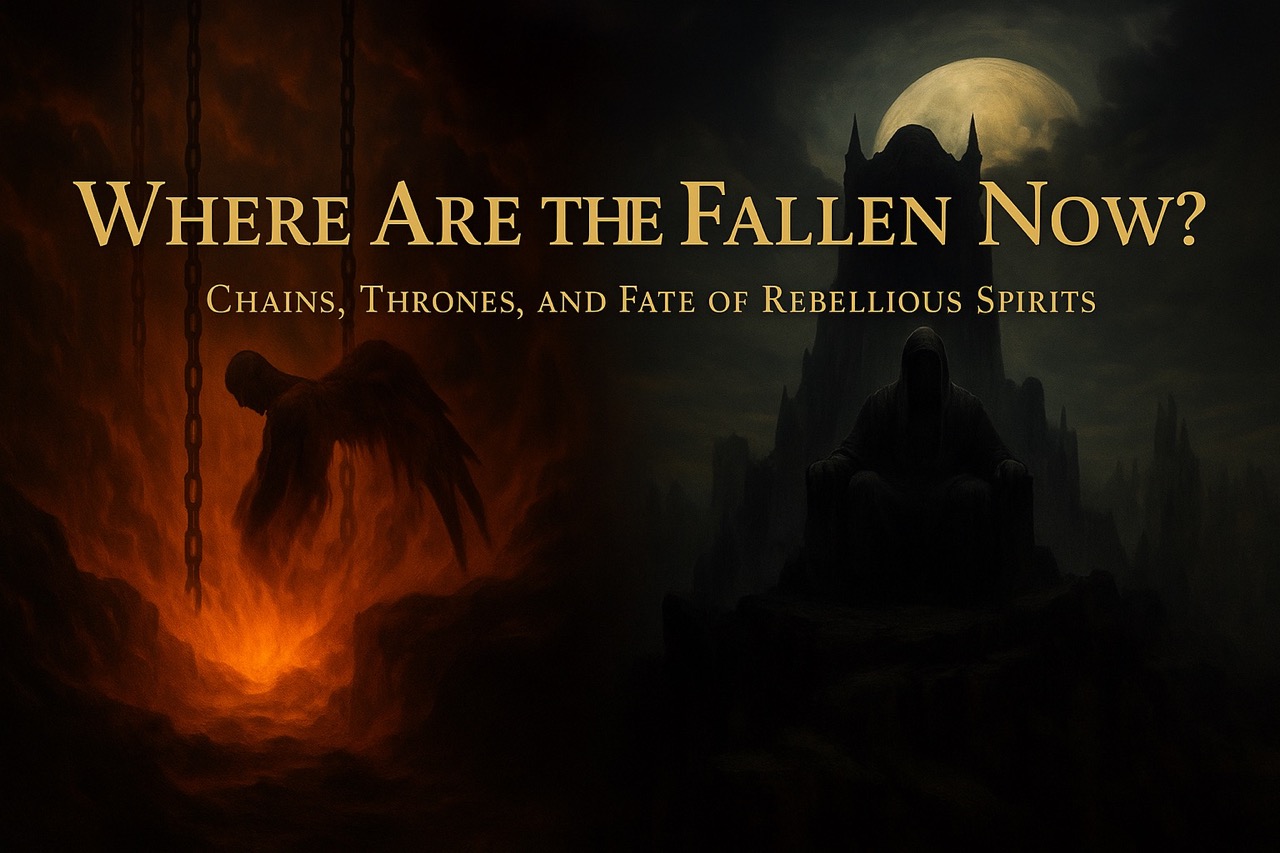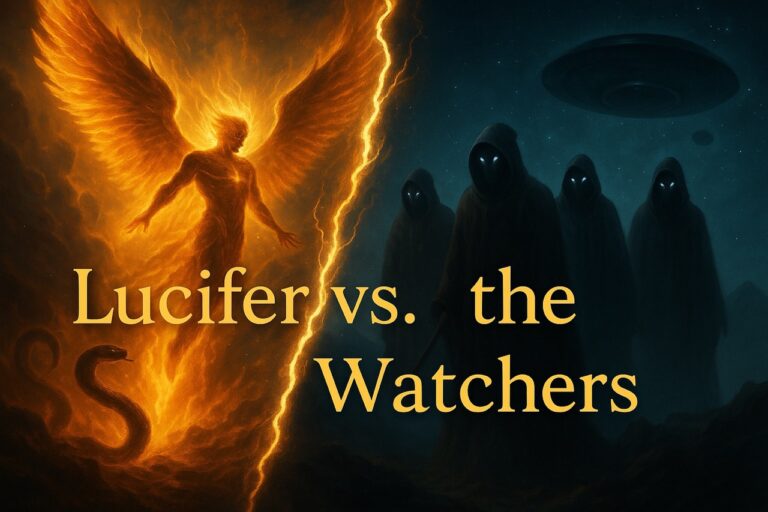The Bible makes a chilling distinction: some fallen angels are held in chains of darkness, while others continue to roam the earth, influencing human affairs and spiritual realities. This raises an important question: Where are demons and fallen angels now? Why are some imprisoned while others remain free to operate?
By examining Scripture alongside ancient texts and theological interpretations, we can uncover the spiritual hierarchy of rebellion. Lucifer’s pride-driven fall differs from the transgression of the Watchers in Genesis 6. Demons, often misunderstood, may not be fallen angels at all—but rather the disembodied spirits of the Nephilim. This article explores how these distinctions affect our understanding of evil today, and how they point toward prophetic events still to come.
Poetic Hook / TL;DR
Some are bound in chains beneath the earth.
Others whisper from thrones of power.
From Tartarus to the Abyss… where are the fallen now?
Before the final judgment, Scripture reveals a haunting divide:
Some rebel angels remain imprisoned. Others roam free.
And their influence runs deeper than most people imagine.
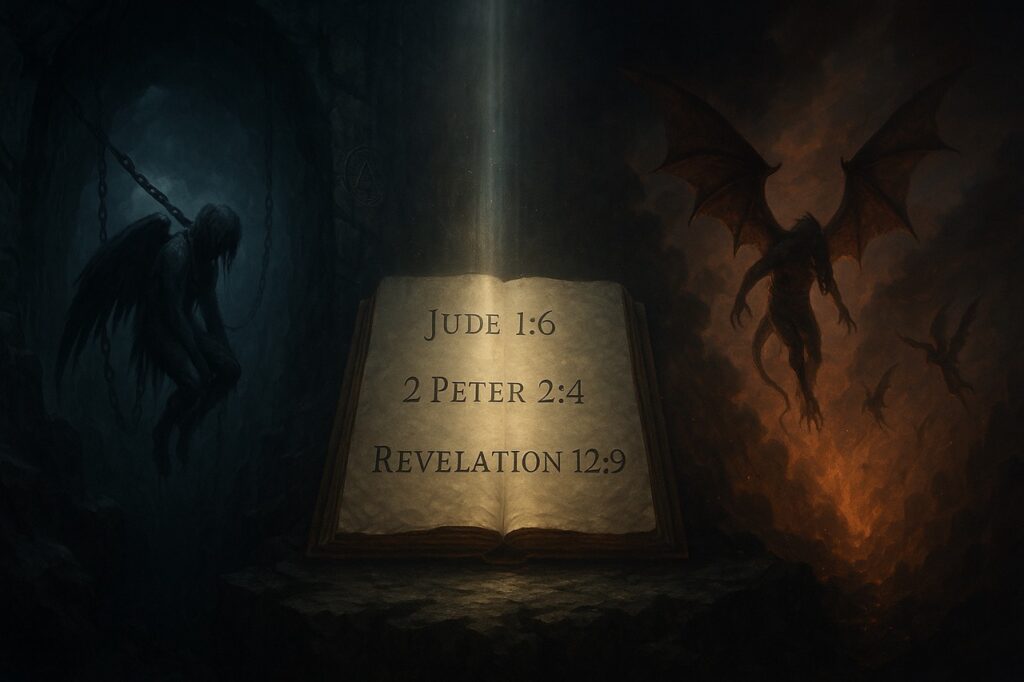
Primary Scriptures: The Divide Between Bound and Free
“And the angels who did not stay within their own position of authority, but left their proper dwelling, he has kept in eternal chains under gloomy darkness until the judgment of the great day.”
— Jude 1:6 (ESV)
“For if God did not spare angels when they sinned, but cast them into hell [Tartarus] and committed them to chains of gloomy darkness to be kept until the judgment…”
— 2 Peter 2:4 (ESV)
“The great dragon was hurled down—that ancient serpent called the devil, or Satan, who leads the whole world astray. He was hurled to the earth, and his angels with him.”
— Revelation 12:9 (NIV)
Taken together, these verses describe two outcomes: some fallen angels are chained, others are cast down but remain active. This distinction invites us to explore who these beings are and what actions led to such dramatically different consequences.

Two Rebellions, Two Fates
Not all angelic rebellions are the same. Lucifer’s uprising, detailed in Isaiah 14 and Revelation 12, stems from pride and the desire to dethrone God. He convinced a third of the angels to follow him, resulting in their collective expulsion from heaven. However, they are not currently imprisoned.
In contrast, the Watchers—referenced in Genesis 6 and extensively described in the Book of Enoch—committed a unique transgression. They descended to earth, took human wives, and introduced forbidden knowledge to humanity. This crossing of divine boundaries triggered immediate judgment: they were cast into Tartarus, a dark spiritual prison reserved for the worst offenders.
This difference reveals a divine legal structure: some sins result in deferred judgment, while others lead to immediate confinement.
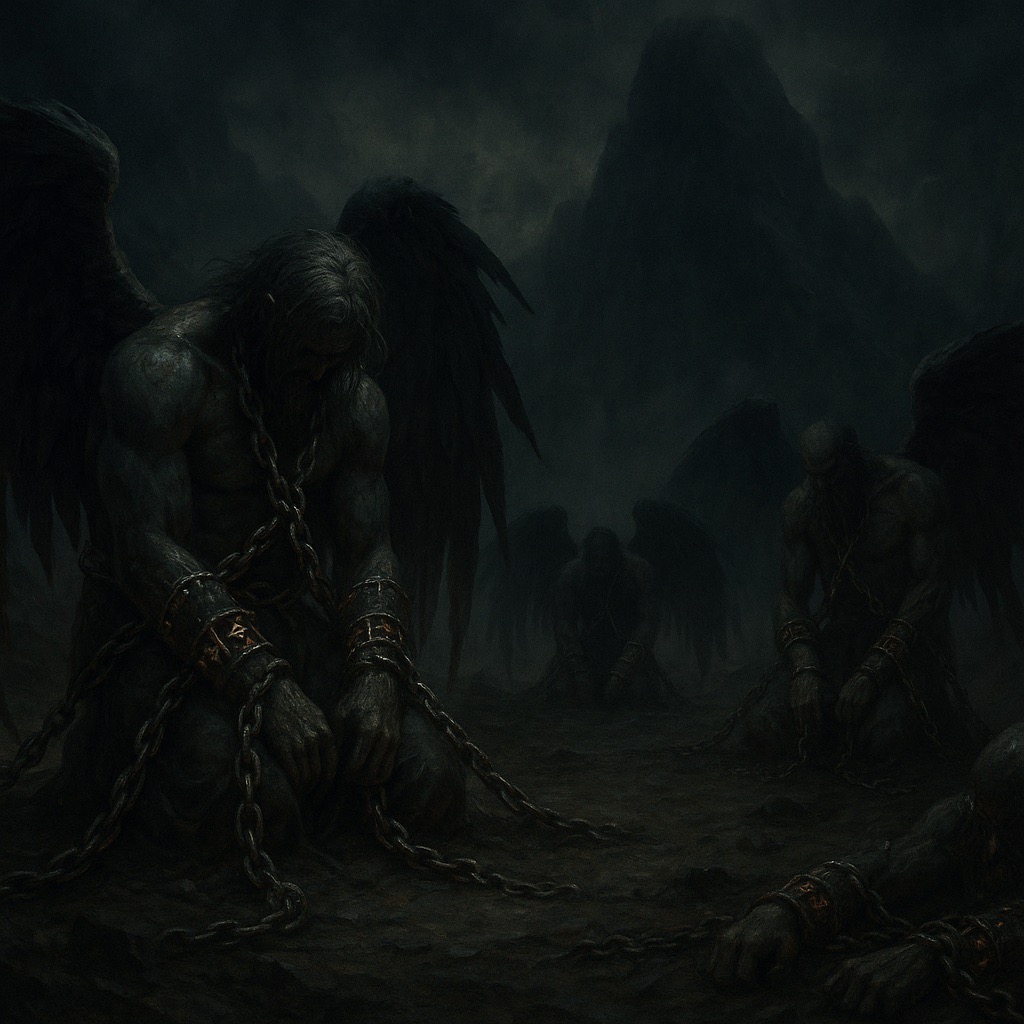
The Watchers: Bound for Judgment
The Book of Enoch offers critical insight into the fate of the Watchers. It tells of 200 angels who descended on Mount Hermon under the leadership of Semjaza and Azazel. Their sin wasn’t just rebellion—it was corruption. They physically mingled with humanity, producing the Nephilim and teaching secrets like weapon-making, enchantments, and vanity.
Peter and Jude affirm this tradition by describing angels bound in gloomy darkness until judgment. The punishment is severe because these angels corrupted creation itself, blending heaven and earth in ways that violated God’s order.
Azazel’s influence is particularly emphasized. He taught humans how to wage war, seduce with cosmetics, and invoke forbidden powers. Enoch states that God banished him to a desert abyss until the final day of reckoning.
Tartarus—the prison mentioned only in 2 Peter—may exist beneath Sheol or in another spiritual realm entirely. In Greek cosmology, it’s a pit reserved for divine rebels. Biblically, it represents the most extreme divine sentence short of the lake of fire.
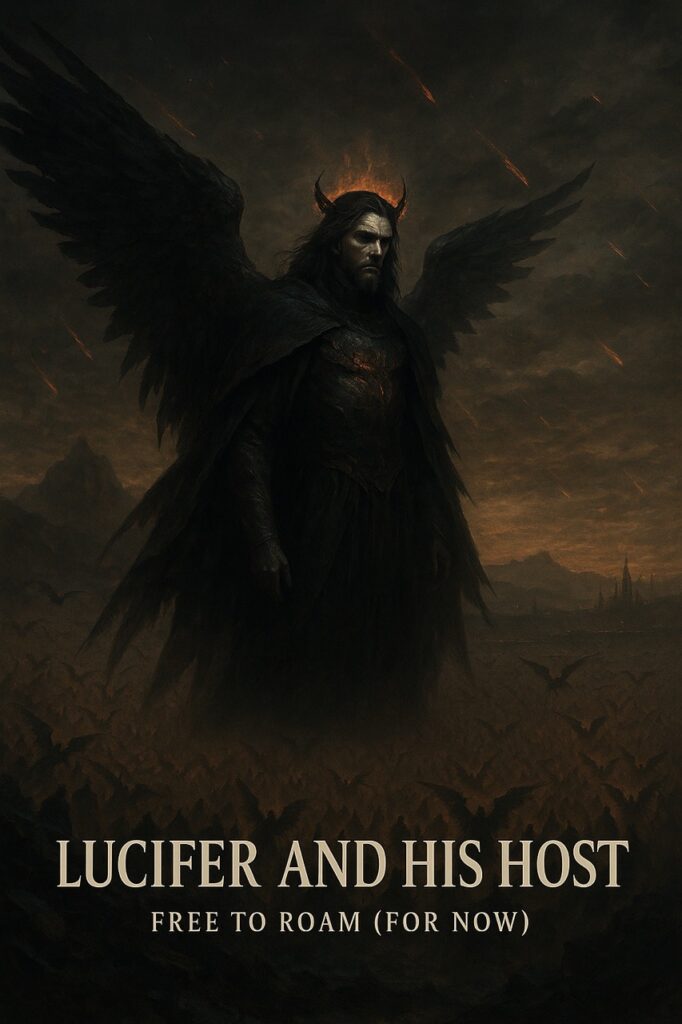
Lucifer and His Host: Free to Roam (For Now)
Satan, in contrast, continues to operate. Revelation 12 depicts him being thrown down to earth, but not bound. He retains freedom to deceive, accuse, and rule over worldly systems until Christ’s final victory.
Paul refers to Satan as the “god of this world” (2 Corinthians 4:4) and the “prince of the power of the air” (Ephesians 2:2). He prowls like a lion (1 Peter 5:8), looking for people to devour. His dominion extends into politics, culture, false religion, and even the church.
Unlike the Watchers, Lucifer’s fall was non-physical. He did not cross into mortal realms in the same way. Therefore, his judgment remains delayed. His spiritual kingdom continues to influence billions—until Revelation 20, when an angel will bind him for 1,000 years.
This distinction helps explain why Satan and his angels remain active: they broke authority, not ontology.
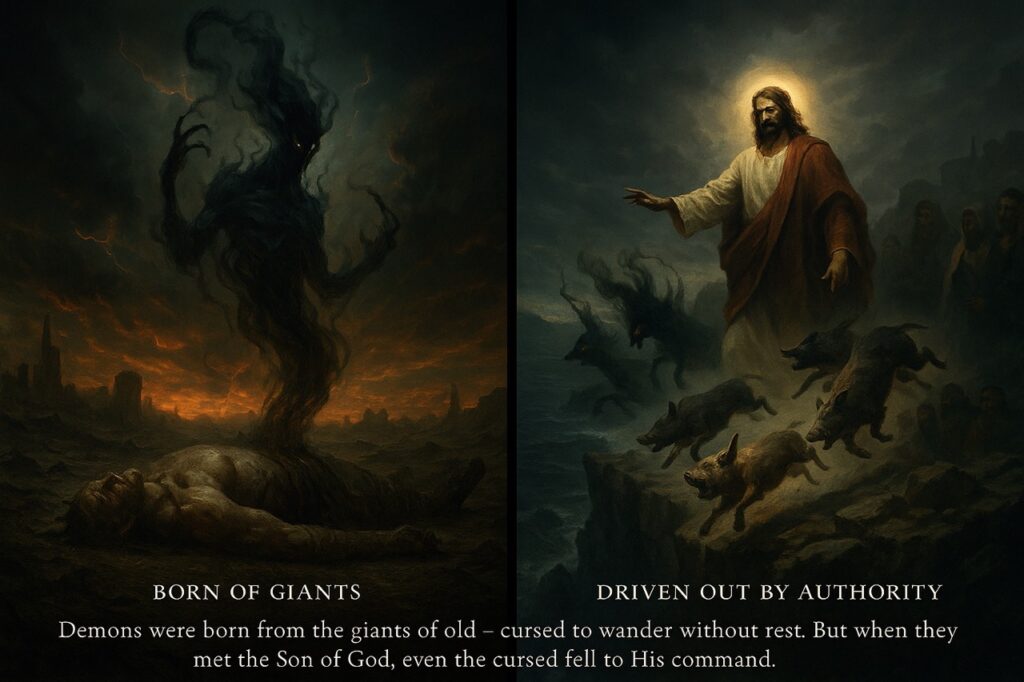
Demons: Spirits of the Nephilim?
The Book of Enoch (chapter 15) introduces a stunning claim: demons are not fallen angels. They are the disembodied spirits of the Nephilim—the hybrid offspring of angels and humans. After God destroyed the Nephilim in the flood, their spirits were cursed to wander the earth.
“And now the giants, who are produced from the spirits and flesh, shall be called evil spirits upon the earth…”
Jesus alludes to this behavior in Luke 11:24, describing unclean spirits roaming through dry places, seeking rest. These beings are:
- Born on earth but infused with heaven’s essence
- Disembodied after the flood
- Malevolent and parasitic
- Constantly seeking to possess living hosts
Unlike fallen angels, these spirits were never part of heaven’s host. Their judgment appears unique. They are not bound, yet they fear the Abyss—a clue that their fate remains unresolved.
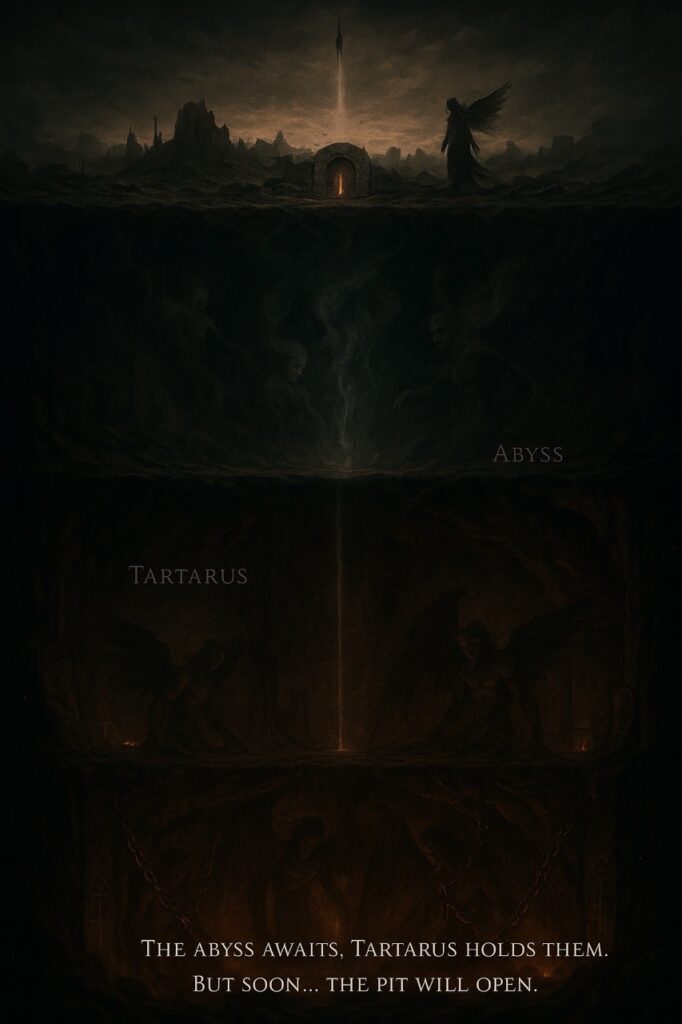
Tartarus, the Abyss, and the Depths
Scripture uses multiple terms to describe the places where fallen beings are confined. Each carries distinct implications:
- Tartarus (2 Peter 2:4): Greek concept adapted by Peter to describe the Watchers’ prison
- The Abyss (Revelation 9): a deep, dark pit from which evil beings rise in the end times
- Luke 8:31: demons beg Jesus not to send them into the Abyss, suggesting it’s a real and feared destination
Biblical cosmology hints that the Abyss may lie beneath the oceans or the earth itself. Revelation 9 describes smoke and locust-like spirits emerging when the Abyss is opened—possibly by a key held by a fallen star (angel). In Jewish apocalyptic thought, this dimension is where the most dangerous beings await final judgment.
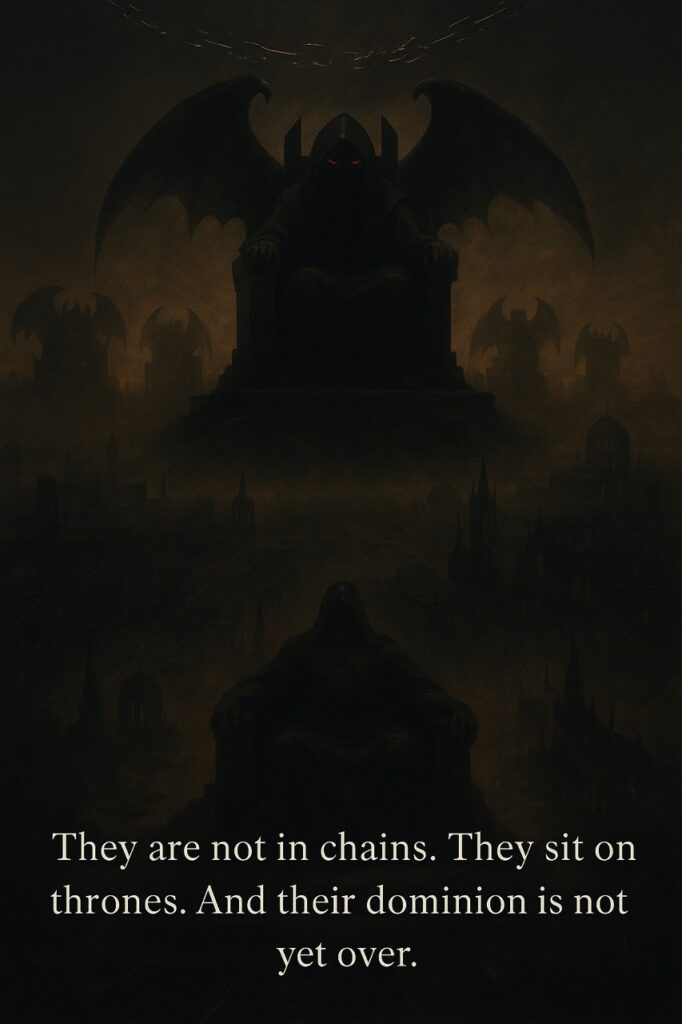
Thrones of Darkness: Where Are the Free Ones Now?
Many fallen beings are not in chains—they are in power.
Ephesians 6:12 warns believers that we fight against “cosmic powers over this present darkness.” Paul’s words describe spiritual thrones and dominions, not abstract ideas. Daniel 10 affirms this with the angelic conflict between Gabriel and the “Prince of Persia.”
Revelation depicts Satan empowering beasts, false prophets, and a counterfeit kingdom. These fallen spirits are likely the original cohort cast down with Lucifer. They operate invisibly through influence—guiding ideologies, movements, and governments to oppose God’s will.
These are the free fallen. They are not yet judged, but their activity is immense. They aren’t hiding—they are governing.
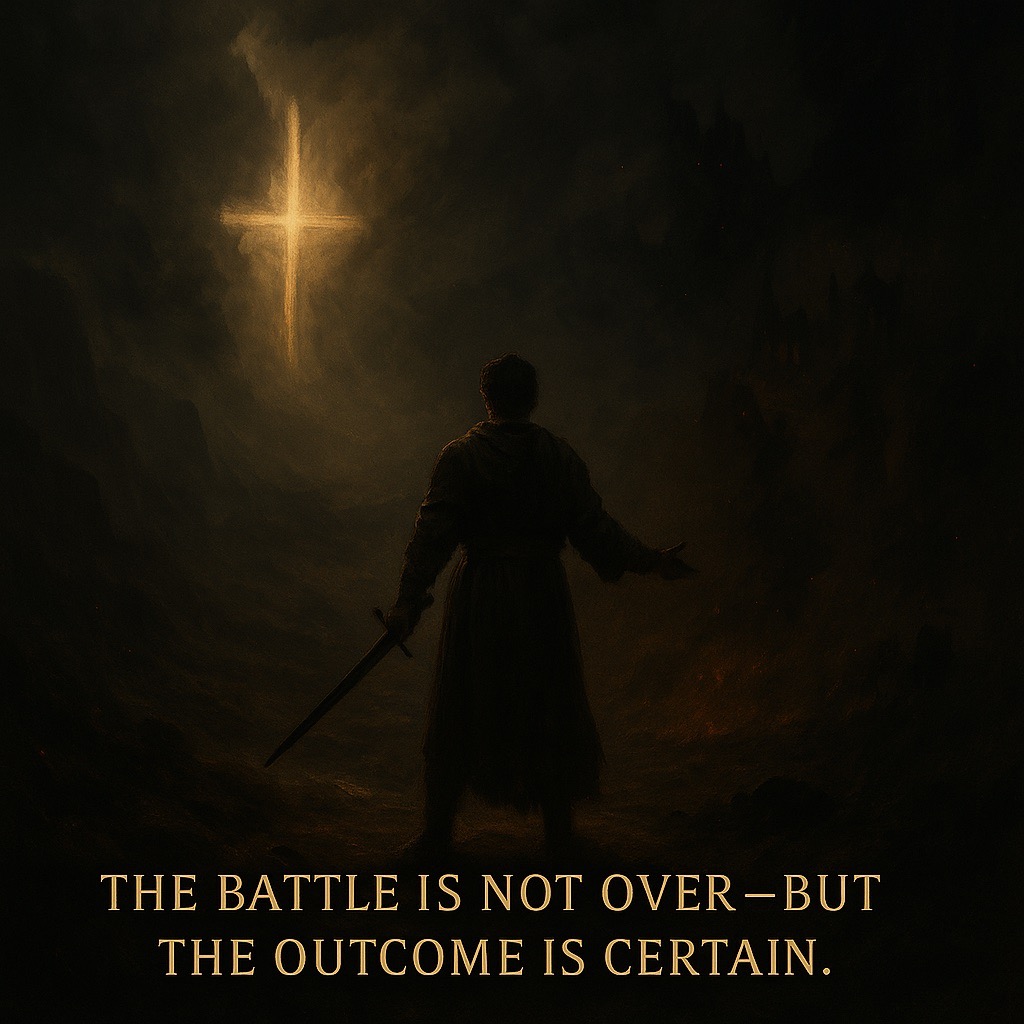
Reflection and Call to Discernment
This subject matters deeply. Spiritual warfare isn’t limited to internal struggles or abstract temptations—it’s geopolitical, cultural, and cosmic. Some spirits are locked away for what they did. Others are free because their judgment awaits. All are part of a war that ultimately points back to the throne of God.
But their power is temporary.
“The God of peace will soon crush Satan under your feet.” (Romans 16:20)
We are not called to speculate—we are called to stand. Jesus holds authority over all things, including the chains and keys of judgment.
Let us walk in discernment, not fear. The chains will not hold forever. The Abyss will open. And justice will arrive.
📖 Related Reading from Paranoid Prophet
Explore deeper into the cosmic rebellion, ancient texts, and prophetic implications tied to this study:
👁️ Watchers & the Genesis 6 Rebellion
- Who Were the Watchers?
- Book of Enoch Explained
- What Did the Watchers Teach?
- Sons of God and Daughters of Men
- Genesis 6 Explained
💀 The Nephilim & Post-Flood Echoes
- Who Were the Nephilim?
- Lucifer vs. the Watchers: Are They the Same Rebellion?
- Ezekiel’s Wheel, UAPs & the Abyss
🔥 Prophetic Themes & End-Time Implications
📚 External Reading: Explore More on Fallen Angels and Demons
Enhance your understanding of the spiritual hierarchies and the fate of rebellious beings with these insightful resources:
🕊️ Understanding Fallen Angels and Demons
- Are Demons Fallen Angels?
An exploration of the identity of demons and their relation to fallen angels.
https://www.gotquestions.org/fallen-angels.html - Fallen Angels: Biblical Truths and Cultural Myths
A study distinguishing scriptural facts from cultural misconceptions about fallen angels.
https://www.biblestudytools.com/bible-study/topical-studies/are-fallen-angels-truth-from-the-bible-or-fiction.html
📖 Deep Dives into Tartarus and the Abyss
- Tartarus — 2 Peter 2:4 Explained
An in-depth look at the term ‘Tartarus’ and its significance in scripture.
https://faithalone.org/blog/tartarus/
📜 Insights from the Book of Enoch and the Watchers
- The Origin of Demons: Watchers and Nephilim
Discusses the historical origins of demons through the lens of the Book of Enoch.
https://www.clintbyars.com/blog/2020/8/3/origin-of-demons-watchers-nephilim - Hebrew Voices: Nephilim and Demons in the Book of Enoch
A podcast episode exploring the complex narratives within the Book of Enoch.
https://www.nehemiaswall.com/hebrew-voices-nephilim-and-demons-in-enoch
📚 Additional Scholarly Perspectives
- Fallen Angels: Understanding Their Role and Influence
Analyzes the impact of fallen angels within biblical narratives.
https://thestandard.org.uk/for-life/worldview/fallen-angels - Book of Enoch: Watchers, Nephilim, and Why It Matters
Explores the significance of the Book of Enoch in understanding spiritual beings.
https://chasingthegiants.com/the-book-of-enochs-story-of-the-watchers-sins-the-giants/
🧠 FAQ: Where Are Demons and Fallen Angels Now?
🧩 Identity & Hierarchy of Fallen Beings
Q: Are demons and fallen angels the same?
No. Demons are often identified as the disembodied spirits of the Nephilim—offspring of angels and humans—while fallen angels are original celestial beings who rebelled against God.
Q: Is Satan a fallen angel or a demon?
Satan is a fallen angel, not a demon. He was cast out of heaven for pride and rebellion but remains spiritually active and unchained until the final judgment.
Q: Who are the Watchers mentioned in the Bible?
The Watchers are a group of angels referenced in Genesis 6 and detailed in the Book of Enoch. They descended to earth, took human wives, and were imprisoned for violating divine boundaries.
Q: How many types of fallen spiritual beings are there?
There appear to be at least three categories: Lucifer and his angels (still active), the Watchers (chained in Tartarus), and the demons (disembodied Nephilim spirits).
📜 Biblical & Historical Origins
Q: What caused some angels to fall from heaven?
Some angels followed Lucifer in rebellion (Isaiah 14, Revelation 12), while others—the Watchers—sinned by mating with human women and corrupting creation (Genesis 6, 1 Enoch).
Q: What is the origin of demons according to the Bible?
While not explicit in canonical Scripture, the Book of Enoch explains that demons are the restless spirits of the Nephilim—giants born from angelic-human unions before the flood.
Q: Did all fallen angels fall at the same time?
No. Lucifer’s rebellion occurred before Genesis 3, while the Watchers’ sin happened during the days of Noah. Their judgments differ based on the nature of their sins.
Q: Why did God flood the earth in Genesis 6?
According to Genesis and Enoch, widespread corruption from the Nephilim and the forbidden acts of the Watchers led God to cleanse the earth through the Flood.
🔒 Locations of Judgment & Imprisonment
Q: Where are the fallen angels now?
Some are bound in Tartarus (2 Peter 2:4), while others—like Satan—roam freely on earth and in the spiritual realm (Ephesians 2:2, Revelation 12:9).
Q: What is Tartarus in the Bible?
Tartarus is a term borrowed from Greek mythology, used in 2 Peter 2:4 to describe a deep prison where especially wicked angels (the Watchers) are held until judgment.
Q: What is the Abyss in Revelation?
The Abyss, or bottomless pit, is a place of darkness and torment. In Revelation 9, it is opened during the end times to release imprisoned evil beings.
Q: Are demons in hell right now?
No. Most demons are not in hell. They remain earthbound and active, seeking to possess hosts (Luke 11:24). Only certain fallen angels are currently bound.
Q: Could the Abyss be located beneath the ocean?
Some biblical and apocalyptic interpretations suggest the Abyss may be connected to the sea, especially since Revelation describes smoke and spirits rising from it.
🌍 Activity in the World Today
Q: Are fallen angels involved in world governments?
Yes. Daniel 10 speaks of spiritual “princes” ruling over earthly kingdoms. Ephesians 6:12 describes demonic rulers and authorities in the spiritual realm influencing global systems.
Q: Can demons possess people today?
Yes. Demons actively seek hosts. Jesus cast out many unclean spirits, and His teachings imply that demonic possession and oppression are real and ongoing.
Q: How do demons differ from Satan?
Satan is a singular entity—leader of the rebellion—while demons are numerous. Satan deceives and rules; demons afflict and inhabit.
Q: Are there modern signs of Watchers or Nephilim?
Some researchers believe that modern UAP phenomena or ancient megalithic structures may point to lingering Nephilim descendants or hidden Watcher activity.
🔮 Prophecy, Judgment & Redemption
Q: Will Satan be chained one day?
Yes. Revelation 20:1–3 prophesies that Satan will be bound for 1,000 years during Christ’s millennial reign, then released briefly before final destruction.
Q: Will demons be judged in the end times?
Yes. Demons, along with Satan and all fallen angels, will be cast into the lake of fire after the final judgment (Matthew 25:41, Revelation 20:10).
Q: Can fallen angels repent?
Scripture does not offer fallen angels a path to redemption. Jude 1:6 implies they are “kept in eternal chains” until judgment, with no mention of grace.
Q: What will happen when the Abyss is opened in Revelation?
Revelation 9 describes terrifying entities—possibly imprisoned Watchers or hybrid spirits—emerging from the Abyss to torment humanity during the Tribulation.

